Updated 12/15/2023 – When thinking about bringing a Goldendoodle into your home, one of the most important questions you might have is, “How big will my Goldendoodle get?” Understanding the full grown size of a Goldendoodle is crucial for prospective owners, as it influences space requirements, exercise needs, and overall care.
Whether you’re curious about the typical height and weight of a standard Goldendoodle or the smaller sizes of mini and toy varieties, we’ve got you covered.
Join us as we explore the fascinating world of “Goldendoodle Sizes,” ensuring you have all the information needed to understand just how big your furry friend might become.
Also in this post we will go over:
- The different Sizes of Goldendoodles
- The full-grown size of the Standard Goldendoodle, Medium Goldendoodle, Mini Goldendoodle and Petite Goldendoodle.
- How you can estimate how big your Goldendoodle will be when fully grown
- A comparison of what breeders say about size vs the reported experiences of Goldendoodle owners.

Why predicting the full-grown size of adult Goldendoodle is difficult
Determining the full-grown size of a hybrid breed like the Goldendoodle can be more challenging than with purebred dogs due to several factors:
- Genetic Variability: Goldendoodles are a cross between Golden Retrievers and Poodles. These two breeds have different sizes – Poodles can be standard, miniature, or toy, and Golden Retrievers are generally a single, larger size. The mixture of genes from two different-sized breeds can result in offspring with a wide range of sizes, making it hard to predict their full-grown size accurately.
- F1, F1B, F2 Generations: The complexity increases with different generations of breeding. For example, an F1 Goldendoodle is a direct cross between a purebred Poodle and a purebred Golden Retriever. An F1B is a backcross in which a Goldendoodle is bred back to a Poodle, often resulting in smaller dogs. F2 Goldendoodles are the result of breeding two Goldendoodles. Each generation can show different growth patterns and sizes.
- Individual Variations: Even within a single litter, there can be significant size variation among puppies. This variation can be influenced by factors like the size of the parents, the number of genes inherited from each breed, and even individual genetic quirks.
- Health and Nutrition: The size of any dog, hybrid or purebred, can also be influenced by its health and nutrition. Puppies that are well-fed and healthy will likely grow to their full genetic potential, while those with health issues or poor nutrition may not.
- Unpredictability in Traits: In hybrid breeding, there is less predictability in traits compared to purebred dogs, where years of selective breeding have established a standard size range. This unpredictability extends to other characteristics as well, such as coat type, temperament, and health predispositions.
How Breeders Estimate the Full-Grown Size of a Goldendoodle
The size of your Goldendoodle as an adult is largely influenced by the size category you select. Goldendoodles come in five distinct sizes: standard, medium, mini, toy or petite, and teacup.
However, these size categories are not always precise indicators of the adult size. Especially in the case of the smaller F1 Goldendoodles, these categories are often estimated guesses made by breeders, based on the size of the breeding dogs and their experience with previous litters.
Breeders may use one of a few methods to predict the future size based on their knowledge and experience. Here are some of the possible approaches:
1. Size determined by Poodle type
With this method, a Goldendoodle’s size category is determined by the size of the poodle. For example if;
- If a Golden Retriever is bred to a mini Poodle, the offspring would be considered mini Goldendoodles.
- A Medium Goldendoodle is the result of Golden Retriever bred to a Moyen Poodle. A Moyen Poodle is the size between a Standard and mini poodle.
- A Golden Retriever bred with a toy poodle result in a toy Goldendoodle. Thought this should never be a F1 pairing.
- Teacup Goldendoodles are often bred using the smallest pups in the litter of toy poodles and a Toy Goldendoodle or two toy Goldendoodles.

This method is not very accurate
This method is still commonly used by inexperienced breeders. But it is not very accurate. Especially, if the parents have a large size difference like with the miniature Goldendoodle.
After all you can’t expect to mate a 60 pound Golden Retriever with a 15 pound mini poodle and get a litter of puppies that are all 20 to 35 pounds and in proportion. Although a couple might end up at this weight range there will also be some that are outside the desired range.
Nor is this the best way to produce Miniature Goldendoodles
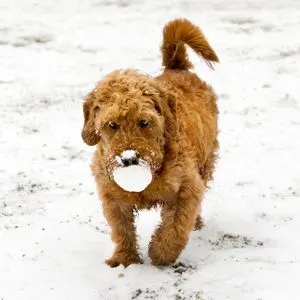
When looking for a mini Goldendoodle it is best to look for a multigen Goldendoodle. Multi-generation Goldendoodles have at least three generations that came before them.
This will give the breeder several generations to breed down a standard sized doodle to a smaller size and avoid structural issues.
The general rule heard in breeders circles is that the difference between two mating dogs should not be greater than 10 pounds. This allows a gradual decrease in size with less potential issues.
So, instead of breeding a full sized Golden Retriever with a miniature poodle to get a Mini Goldendoodle, they would match a smaller Golden to a small standard Poodle or a true Moyen Poodle, to get a medium sized F1 Goldendoodle.
Then, mate the smaller F1 Goldendoodle to a smaller poodle, resulting in an F1 b Goldendoodle.
This process is repeated until the puppies are consistently a smaller size.
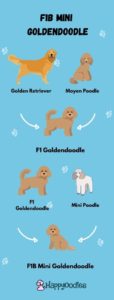
There are still some issues with this method. One of them being that every dog has two genes for each trait including size. One gene is always recessive and one dominant. These genes combine with other genes to determine a dog’s looks, size and other traits.
This means a dog can carry a recessive gene for lets say tall height but maybe short themselves. While they may be short they can pass the tall gene down to their off-spring.
It’s not uncommon to hear from breeders of F1 or F1B doodles that state while most of the litter were in the predicted range they still have one or two outliers that were smaller or bigger than the average.

Trying to decide between a mini Goldendoodle and a standard Goldendoodle. Check out our post in the subject to see which one might be a better fit.

2. Wait until they grow up
Another way to establish the size range of a Goldendoodle is to wait until they are fully grown. This is the method used by the Goldendoodle Association of North America.
Final size category of a dog will be determined at adulthood and is measured at the withers. Please be aware that the estimated size of a puppy by a breeder is an educated guess; therefore, a puppy’s final size may vary somewhat from a breeder’s initial calculation.
Goldendoodle Association of North America
Of course waiting for your future puppy to grow up to determine their size is not useful when you are looking for your future dog to be a certain size or wondering how big your Goldendoodle puppy will be by the time they will stop growing.
But reputable breeders will not only have knowledge of the dog’s ancestors but will also keep in touch with their puppy’s families to know how big previous litters have grown. This combined information should allow them to predict the size of future litters with some accuracy
The below chart shows the GANA Goldendoodle Breed Standard for size. Members of GANA strive to match these standards. But as you can see from the above statement from GANA, breeders should not guarantee the size.
GANA Goldendoodle Size Chart
| Size Range | Average Height Range | Average Weights |
| Petite | Below 14 inches | 25 lbs. or less |
| Miniature | Over 14 but under 17 inches at wither | 26-35 lbs. |
| Medium | Over 17 but under 21 inches at wither | 36-50 lbs. |
| Standard | Over 21 inches at wither | 51 or more lbs. |
How Big is a Full Grown Goldendoodle?

How big do Goldendoodles get?
Breeders state that most standard Goldendoodles will be 50 or more pounds and 21 inches or taller at the shoulder when fully grown Males Goldendoodles are typically larger than female Goldendoodles. This matches the data collected from Goldendoodle owners who reported weights between 50 and 110 pounds for their adult Goldendoodles.

How big is a full grown mini Goldendoodle?
According to breeders a full grown mini Goldendoodle should be between 26 to 35 pounds and 14 to 17 inches tall at the shoulder. But people reported that their “Mini” Golden doodle ranged anywhere between 15 to 35 pounds when full grown.
As I pointed out above the doodle generation will have an effect on the size of your Goldendoodle. Later generations will have more consistency in size than first generation mini doodles.
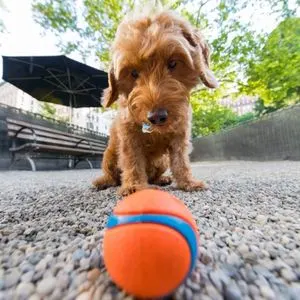
How big is a fully grown toy Goldendoodle?
The Goldendoodle Association lists a petite Goldendoodle as their smallest size. This size range includes the toy, Micro mini and teacup Goldendoodles. Breeders state that a petite Goldendoodle is under 14 inches tall and weighs less than 25 pounds.
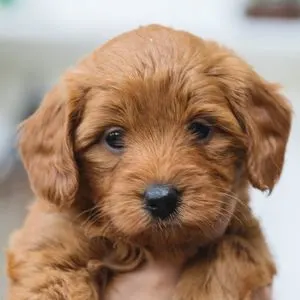
How big are medium Goldendoodles when fully grown?
The medium sized Goldendoodle is a relatively new size. They were once considered a small standard, but as more people started looking for a medium sized dog, breeders strive to breed more Goldendoodle in this size range.
The estimated size range of a Medium Goldendoodle when fully grown is approximately 17 to 21 inches tall and 36-50 lbs.

Trying to decide between a mini Goldendoodle and a standard Goldendoodle. Check out our post in the subject to see which one might be a better fit.
When does a Goldendoodle stop growing?
It depends on the size of the Goldendoodle. Larger dogs take a longer time to grow.
Since the Golden Retriever and Standard Poodle have about the same growth timeline it’s easy to estimate how long it will take for the Standard Goldendoodle to reach their adult height and weight.
As you can see from the chart below the Standard Poodle reaches their full size by the time they reach 2 years old. A Golden Retriever reaches their full height a little sooner than the Poodle which is taller, but they take a little longer to reach their full weight.
This means that a standard sized Goldendoodle should reach their adult height around 1.5 years old. It will take another 6 months to a year for them to fill out and reach their adult weight.
Size chart for the Golden Retriever and Poodle
| Breed | Age when they reach Full Height | Age when they reach Full Weight |
| Golden Retriever | 16 months | 2+ years |
| Standard Poodle | 18 months | 24 months |
| Mini Poodle | 8-9 months | 12 months |
| Toy Poodle | 6-7 months | 10 months |
Remember these are estimates based on averages. Individual dogs may reach their adult size a little sooner or later than the average.
But it is harder to estimate when the medium, mini and toy Goldendoodles will stop growing because of the difference in size between the Golden and smaller poodles. As I mentioned above, large dogs take longer to grow than smaller dogs.
So, instead of estimating based on parent breeds, we looked at self reported data from Goldendoodle owners to see when their doodles stopped growing.

As you can see from the chart below Goldendoodle owners reported that their standard Goldendoodle stopped growing between 1 and 2 years. Most Goldendoodles stopped growing in height by their first birthday. Medium Goldendoodles took a little less time. They stopped growing by 1.5 years and mini Goldendoodles reached their full size by the time they were a year old. The petite Goldendoodle was finished growing by 9 months old.
Goldendoodle Size Chart – based on self-reported data from Goldendoodles owners
| Goldendoodle Size | Age when they reach Full Height | Age when they reach Full Weight |
| Standard | 10 to 12 months | 1 to 2 years |
| Medium | 6 to 7 months | 9 to 18 months |
| Mini | 6 months | 8 to 12 months |
| Toy | 6 months | 6 to 9 months |
| Teacup | 6 months | 6 to 8 months |
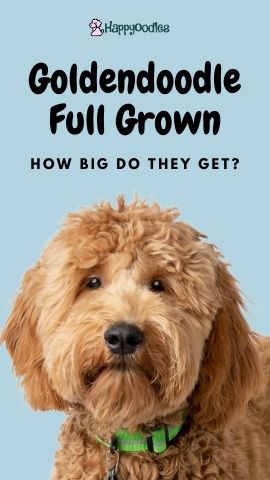
How accurate are size estimates for Goldendoodles?
As you can see the estimated size of a Goldendoodle puppy when fully grown is not always accurate. In a poll Goldendoodle owners were asked if the size estimate given by their breeder was accurate. Here are the results.
- 58% of responders stated that their mini Goldendoodle did not fall within the expected weight range of their adult size.
- 45% expected their pup to be smaller
- 13% expected their pup to be larger
- 42% grew to the expected size.
Goldendoodle Full Grown Size Estimates Accuracy
| Goldendoodle Mini | Percentage that were accurate |
| Weighed more than expected | 45% |
| Weighed in the expected range | 42% |
| Weighted less than expected | 13% |

How to determine the size of your Goldendoodle?
There are a few ways you can estimate how big your puppy may get.
Talk to your breeder
The first way I would recommend is to talk to your breeder. They should have first hand knowledge about your puppy’s parents, and grandparents. They should also know basic information about their great grandparents. Especially if the breeding dogs were AKC purebreds.
Assuming they are an experienced Goldendoodle breeder, they should also have some information about previous litters and how big they have grown to.
This should help estimate how big your puppy will get. Though this is not 100 percent foolproof. Goldendoodle puppies can inherit unseen traits that hadn’t been visible in past generations.
2. Use a simple calculation
Another common way is to use this simple calculation:
- For a standard-sized Goldendoodle, double your puppy’s weight at 16 weeks of age and add 5 pounds.
- Minis just double their weight at 16 weeks but don’t add any extra weight. We put this to the test with full grown Cavapoos and found that the calculation was fairly accurate for smaller Cavoodles, and only slightly off for larger Cavapoos. But the sampling was small.
3. Weight Calculators
This is similar to the calculation above but instead of you doing the math, they do it for you. Most will ask for your puppy’s age and current weight. They are only semi-accurate because most do not ask if the dog is a large or small breed.
4. DNA tests
DNA tests look for genetic indicators to tell whether your dog will be a large or small dog. There is still a lot of research that needs to be done before they are completely accurate. One Goldendoodle owner reported that a DNA test predicted that her dog would be twice the weight she ultimately ended up being.
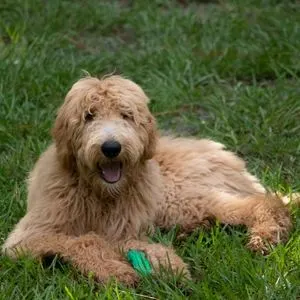
When do Goldendoodles calm down?
When you first bring home your little fur baby, they are often scared and tired. This translates to a pup that is low key and sleeps a lot.
But once they settle in they become a big ball of destructive energy. You will find that they want to play all the time, voluntary naps are a thing of the past and your hands have become their favorite chew toy.
At this point you may be wondering when your Goldendoodle will calm down and turn into the wonderful dog you always heard about. You may even start regretting getting a puppy.
But don’t despair. With the right training your Goldendoodle puppy will settle down once they reach adulthood at around one year old. This is the average age for Goldendoodles, smaller Goldendoodles may settle down sooner and large Goldendoodles may take a little longer.
To help settle them down sooner I suggest taking them to a puppy kindergarten class with an experienced trainer. Starting training early will help with many of the issues you will deal with when they go through their adolescence period at 6 to 18 months.

MD Mondo
Sunday 18th of February 2024
We have a puppy. Parents are standard poodle and either Golden Retriever or Goldendoodle. He is almost 6 months old. 38 pounds. Sweet and sometimes rambunctious. His hair is a frizz bomb. I love him like mad.
Juwayne Edwards
Wednesday 10th of January 2024
My 5 month old goldendoodle is a vary rambunctious little boy , he doesn't understand no bitting...he's getting his first full grooming this Friday January 12th ...I'm looking forward to see if he's going to develop curls or stay with straight hair , his papers says he a miniature but he's bigger then all of the photos I've seen of miniatures...I'd love to own one of those really big ones to have trained as a Mobility dog
Bonnie
Wednesday 10th of January 2024
Hi!
Congratulations on your new puppy! Enjoy every minute of their first year cause it goes by fast. Most puppies grow out of their biting phase by 6 to 8 months so you are almost there. Let us know how big your puppy gets when he is grown.
Thank you for stopping by and sharing! Bonnie
Kathy
Monday 8th of January 2024
We have a new baby goldennoodle and she is 10 weeks old and is already big. She is a quick learner also.
Bonnie
Monday 8th of January 2024
Hi!
Congratulations on your new puppy! Let us know how big she gets and how big she was when you first got her.
Thanks for stopping by and sharing!
Bonnie
shawn
Tuesday 14th of March 2023
i have one hes 110 lbs and a great dog